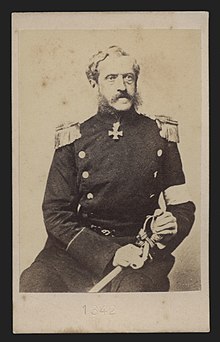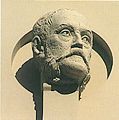Bernhard von Langenbeck
Bernhard Rudolf Konrad Langenbeck , from 1864 von Langenbeck , (born November 9, 1810 in Padingbüttel , Kingdom of Hanover , † September 29, 1887 in Wiesbaden ) was a German surgeon . From 1848 to 1882 he was professor at the Second Surgical Clinic in Berlin. He was one of the most important representatives of surgery of his time.
Life
Langenbeck's parents were the pastor Georg Langenbeck (born September 26, 1766, † December 12, 1844) and Johanna Charlotte Elisabeth Sussmann. After his father was appointed superintendent in Sandstedt in 1827, Langenbeck, previously taught only by his father, was placed at the Andreas Gymnasium in Hildesheim and at the boarding school there. After obtaining his school-leaving certificate, he began studying medicine at the Georg-August University in Göttingen in 1830 , where his uncle Konrad Johann Martin Langenbeck taught anatomy and surgery as a professor. The nephew received his doctorate in 1835 with the dissertation De retinae structura penitiore (On the internal structure of the retina ) . A year later he published the study De retina observationes anatomica-pathologicae (About the retina - anatomic-pathological observations) . Langenbeck received a scholarship for this study, which made a two-year study trip to England, France, Holland and Belgium possible for him. Since 1829 he was a member of the Corps Hassia Göttingen. He later became an honorary member of the corps.
After the study trip , Langenbeck completed his habilitation in 1838 in Göttingen as a private lecturer in physiology and pathological anatomy. He was appointed associate professor in the summer semester of 1841. As early as 1842 he was appointed professor of surgery at the Christian Albrechts University in Kiel , which was located in the palace gardens until it was destroyed in the Second World War . Langenbeck also headed the nearby Friedrichshospital on Flämische Strasse in Kiel.
Proposed as his successor eight days after the death of Johann Friedrich Dieffenbach , Langenbeck took over the management of the Charité surgery in Berlin on May 13, 1848 . His successor in Kiel was Louis Stromeyer . In the period from 1848 to 1882, Langenbeck made the Charité Surgical Clinic the center of surgery in Europe. He also worked at the Jewish Hospital . In 1866/67 he was the rector of the university.
Foundations
In 1860, Langenbeck, together with his students Theodor Billroth and Ernst Julius Gurlt, founded the journal Archive for Clinical Surgery , which still exists today as Langenbeck's Archives of Surgery . He was the initiator of the German Society for Surgery in 1872 , of which he was president until 1885.

Despite his specialization in surgery within medicine, close contact with the general medical profession and their wide-ranging advanced training was very important to him - like Rudolf Virchow . For this reason he founded the Berlin Medical Society with R. Virchow and Albrecht von Graefe in 1860 (see link), and he was elected chairman from 1872 to 1882. Both companies today again own the Langenbeck-Virchow-Haus in Berlin's Luisenstrasse, whose facade and rooms are reminiscent of von Langenbeck (see below).
Military career
As a medical officer in the Prussian Army , Langenbeck took part in all German unification wars. In the Schleswig-Holstein War (1848-1851) the duchies against Denmark and in the German-Danish War (1864) he was used as a general staff doctor. For his services , King Wilhelm I raised him to the hereditary Prussian nobility on July 9, 1864 .
As general doctor, Langenbeck took part in the campaign against Austria in 1866 and in the war against France in 1870/71 . Since December 24, 1872, Langenbeck was a la suite of the medical corps. In this position he received the personal rank of Lieutenant General and the title of Real Privy Councilor in 1882 .
He treated Kaiser Wilhelm I after the assassination attempt by Karl Eduard Nobiling on June 2, 1878.
family
Langenbeck married Arnoldine Reinbold on April 8, 1840 in Himmelpforten (born July 9, 1817 in Hanover, † December 4, 1886 in Wiesbaden). The marriage resulted in two sons and three daughters:
- Arnold Georg Eduard (1841–1916), Prussian general of the cavalry
- Anna (* 1843)
- Karl Friedrich Julius (1846–1870), killed as a Prussian Second Lieutenant in the Guard Rifle Battalion near Rezonville
- Helene (1848–1907) ⚭ Arnold von Roon (1840–1906), Prussian infantry general
- Elisabeth (1850–1917) ⚭ 1874 Hans von Plessen (1841–1929), Prussian Field Marshal General
The family grave is located on the Old St. Matthew Cemetery Berlin, marked as the honor grave of the city of Berlin .
Act
Langenbeck became world famous for operations on the face and head, among other things. He is also considered a pioneer in neurosurgery. In 1858 he tried to treat an unhealed fracture of the femur with a metal screw (introduced transtrochanterically).
Instruments
Langenbeck developed new instruments named after him:
- Wing forceps for grasping individual pulled hemorrhoids
- Amputation knife
- Bone forceps
- Cartilage knife
- Retractor: a broad, long and blunt hook with a blade bent at right angles
- Needle holder
student
- Theodor Billroth
- Karl David Wilhelm Busch
- Friedrich von Esmarch
- Carl Hueter
- Rudolf Ulrich Krönlein
- Karl Schönborn
- Friedrich Trendelenburg
- Karl Ernst Albrecht Wagner
- Carl Ludwig Schleich .
Commemoration
- Memorial plaque in Göttingen, Obere Maschstraße 6, for the period of residence from 1838 to 1842.
- Head bust at Langenbeck-Virchow-Haus in Berlin, Luisenstrasse 58 by CFE Hartzer 1882
- Oil painting by Ismaél Gentz on the first floor of the Langenbeck-Virchow-Haus, Berlin, Luisenstr. 58 on the occasion of the establishment of the German Society for Surgery. Here von Langenbeck and Billroth stand across from Victor von Bruns (1812–1883) surgeon and founding member of the German Society for Surgery (still not illustrated, see reference Peiper, HJ)
- Head bust B. von Langenbeck. Original sculpture on Langenbeck-Virchow-Haus by the Potsdam sculptor Golter (2004), donated by the Aeskulap company.
- Wall portrait, Chir. Clinic University Hospitals Heidelberg, EG-Halle.
- Langenbeckplatz and Langenbeckstraße in Wiesbaden were named after him.
- The German Society for Surgery has been awarding the renowned Von Langenbeck Science Prize every two years since 1954 and annually since 1968 for special scientific achievements in the field of surgery.
literature
- Ronald D. Gerste: From physiology to surgery, from microscope to resection knife. For the 200th birthday of the great surgeon Bernhard von Langenbeck. Chirurgische Allgemeine , Vol. 12, 4/2011, pp. 291-195.
- Richard Hoche: Langenbeck, Bernhard von . In: Allgemeine Deutsche Biographie (ADB). Volume 51, Duncker & Humblot, Leipzig 1906, p. 581.
- Markwart Michler : Langenbeck, Bernhard von. In: New German Biography (NDB). Volume 13, Duncker & Humblot, Berlin 1982, ISBN 3-428-00194-X , pp. 580-582 ( digitized version ).
- HJ Peiper: The Langenbeck-Virchow-Haus as reflected in the history of the German Society for Surgery. Einhorn-Presse Verlag 2001.
photos
Web links
- Literature by and about Bernhard von Langenbeck in the catalog of the German National Library
- Berlin Medical Society
- History of the Langenbeck-Virchow-Haus
- Langenbeck in the Wiesbaden city dictionary
Individual evidence
- ↑ Kösener corps lists 1910, 73 / 74a.
- ↑ Marcelli Janecki , Preußischer Heroldsamt (Ed.): Handbook of the Prussian Adels. First volume, ES Mittler & Sohn , Berlin 1892, p. 331.
- ^ Military weekly paper . No. 4 of January 13, 1883, p. 59.
- ↑ Gothaisches genealogical pocket book of the count's houses, 1876, p. 733
- ↑ Barbara I. Tshisuaka: Langenbeck, Bernhard Rudolf Konrad von. In: Werner E. Gerabek , Bernhard D. Haage, Gundolf Keil , Wolfgang Wegner (eds.): Enzyklopädie Medizingeschichte. De Gruyter, Berlin / New York 2005, ISBN 3-11-015714-4 , p. 824.
- ↑ Thomas Schlich: Osteosynthesis. In: Werner E. Gerabek et al. (Ed.): Enzyklopädie Medizingeschichte. 2005, p. 1083 f .; here: p. 1083.
| personal data | |
|---|---|
| SURNAME | Langenbeck, Bernhard von |
| ALTERNATIVE NAMES | Langenbeck, Bernhard Rudolf Konrad von (full name); Langenbeck, Bernhard |
| BRIEF DESCRIPTION | German surgeon, university professor |
| DATE OF BIRTH | November 9, 1810 |
| PLACE OF BIRTH | Padingbüttel |
| DATE OF DEATH | September 29, 1887 |
| Place of death | Wiesbaden |






